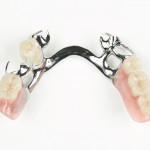
The shortened dental arch (SDA) has been defined as having an intact anterior region but a reduced number of occluding pairs of posterior teeth. The World Health Organization has stated that the retention, throughout life, of a functional, aesthetic, natural dentition of not less than 20 teeth and not requiring recourse to prostheses should be the treatment goal for oral health. As a result the replacement of missing molar teeth with complex restoration could amount to over treatment.
The aim of this multi centre trial was to assess the outcomes for two different treatment options for the shortened dental arch.
What did they do
Patients over 35 years of age with complete molar tooth loss in one jaw were randomized to receive either a partial removable dental prosthesis (PRDP) retained with precision attachments(n= 109) or, in the SDA group ( n= 106) no prosthetic extension of the dental arch was conducted if the posterior-most tooth was the second premolar. If the posterior-most tooth was the first premolar, a cantilever FDP for replacement of the second premolar was incorporated. In both groups, missing anterior teeth were replaced by fixed dental prostheses (FDPs). The opposing jaw had to be sufficiently restored up to the first molar in the PRDP group or the second premolar in the SDA group. The primary outcome was tooth loss, secondary outcomes were decayed missing and filled teeth and plaque index.
What did they find
- 152 of the recruited patients were treated with 132 available at the 5-year examination.
- 38 patients lost teeth between baseline and 5-year examination 22 in the PRDP group, 17 in the SDA group
- For the primary outcome tooth loss the Kaplan–Meier survival rates at 5 years were:-
- For first tooth loss = 0.74 (95 % CI0.64, 0.84) in the PRDP group, 0.74 (95 % CI 0.63,0.85) in the SDA group.
- For tooth loss in the study jaw =0.88 (95 % CI 0.80, 0.95) in the PRDP group and 0.84 (95 % CI 0.74, 0.93) in the SDA group.
- The differences were not significant.
The authors concluded
The overall treatment goals of a sustainable oral rehabilitation and the avoidance of further tooth loss over longer periods were not reliably achievable. The influence of the type of prosthetic treatment on tooth loss might have been overestimated.
Links
Walter MH, Hannak W, Kern M, Mundt T, Gernet W, Weber A, Wöstmann B, Stark H, Werner D, Hartmann S, Range U, Jahn F, Passia N, Pospiech P, Mitov G, Brückner J,Wolfart S, Busche E, Luthardt RG, Heydecke G, Marré B. The randomized shortened dental arch study: tooth loss over five years. Clin Oral Investig. 2012 Jun 26.[Epub ahead of print] PubMed PMID: 22733244.
